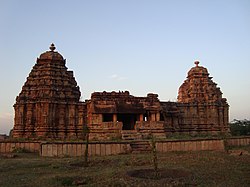Sudi (Karnataka)
| Sudi ಸೂಡಿ |
||
|---|---|---|
|
|
||
| State : |
|
|
| State : | Karnataka | |
| District : | Gadag | |
| Sub-district : | Ron | |
| Location : | 15 ° 44 ′ N , 75 ° 52 ′ E | |
| Height : | 600 m | |
| Area : | 25.91 km² | |
| Residents : | 5,976 (2011) | |
| Population density : | 231 inhabitants / km² | |
| Sudi - Jodu Kalasa Temple | ||
Sudi ( Kannada ಸೂಡಿ ) is a place with about 6,500 inhabitants in the municipality ( taluk ) of Ron in the north of the Indian state of Karnataka .
Location and climate
The place Sudi is at an altitude of approx. 600 m, almost 50 km (driving distance) northeast of the district capital Gadag-Betageri and approx. 35 km southeast of Badami . Itagi, which is important because of its medieval temple, is located approx. 44 km southeast. The climate is subtropical ; Rain (average approx. 805 mm / year) falls almost exclusively in the summer monsoon season.
population
The majority of the village's Kannada- speaking population consists almost exclusively of Hindus . The male part of the population exceeds the female population by approx. 3%.
economy
Agriculture traditionally plays the largest role in economic life; Grains, lentils and vegetables of all kinds are grown. Small traders, artisans and day laborers have settled in the village.
history
The first news about the place comes from around 1000 AD when Sudi (old name Sundi ) was part of the Chalukya empire; at the end of the 11th century it was a kind of district capital with its own mint. In the 12th century, the Chola from southern India took over their positions of power until it was taken over by the Vijayanagar Empire in the 14th century , which itself was lost in the Battle of Talikota in 1565 .
Attractions
- The one-tower Mallikarjuna temple stands in the middle of the village; it is still in use and therefore looks a bit untidy overall. Inside there is a black statue of the resting Vishnu - Narayana and a portal with water monsters ( makaras ) in the fall .
- The two-towered Jodu Kalasa temple, which ends with kalasha jugs, stands outside the village and is dedicated to the Hindu god Shiva , whose tower structure ( vimana ) is slightly higher than the tower opposite with an empty cella ( garbhagriha ) . Both components are connected by a vestibule ( mandapa ) in which a large stone Nandi bull lies. While the interior of the two cellae is largely dark and unadorned, the vestibule resting on turned columns appears airy and almost floating.
- An unadorned step well , called nagakunda , leads down to the former water table .
- In the village there is a small temple with a huge Ganesha statue.
- A free-standing black Shiva lingam decorates the town center.
Web links
- Sudi, Tempel - Photos + Info (English)


